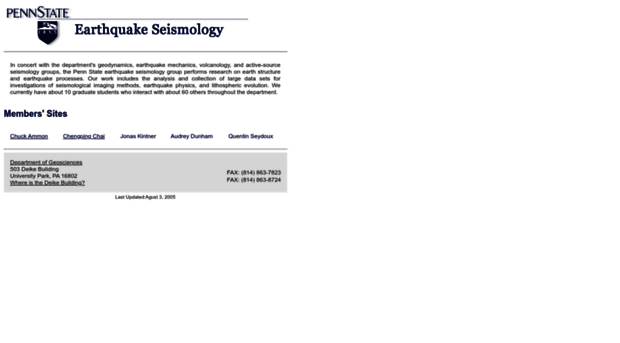MYWOT
Child safety
Confidence
Trustworthiness
Confidence
MALICIOUS CONTENT INDICATORS
Eqseis.geosc.psu.edu most likely does not offer any malicious content.
Secure connection support
HTTP
Eqseis.geosc.psu.edu has not yet implemented SSL encryption.
ADULT CONTENT INDICATORS
Eqseis.geosc.psu.edu most likely does not offer any adult content.
Popular pages
-
Penn State Earthquake Seismology
In concert with the department's geodynamics, earthquake mechanics, volcanology, and active-source seismology groups, the Penn State earthquake seismology group performs research on earth ...
-
Seimic Waves and Earth’s Interior
Introduction When you look at a seismogram the wiggles you see are an indication that the ground is being, or was, vibrated by seismic waves. Seismic waves are propagating vibrations that carry ene...
-
Earthquake Location Activity
. Charles J. Ammon, Penn State This is a simple, interactive earthquake location activity developed for use in introductory earthquake seismology classes. The traditional triangulation exercises a...
-
Search the USGS Earthquake Catalog
Search the USGS Earthquake Catalog For moderate-size earthquakes, perhaps the best place to look for information information on a moderate-size (say, M ≥ 5) earthquake that occurred since 1973 is the ...
-
EAS111 - C4 - Types of Sediment
gravity strata Clastic Sediments Clastic sediments are composed of fragments or grains (or clasts) of other rocks and minerals. We classify clastic sediments based on their grain size: [Study Figure 4...
-
Waves, Seismometers, and Seismograms
The fundamental observations used in seismology (the study of earthquakes) are seismograms which are a record of the ground motion at a specific location. Seismograms come in many forms, on "smoked" ...
